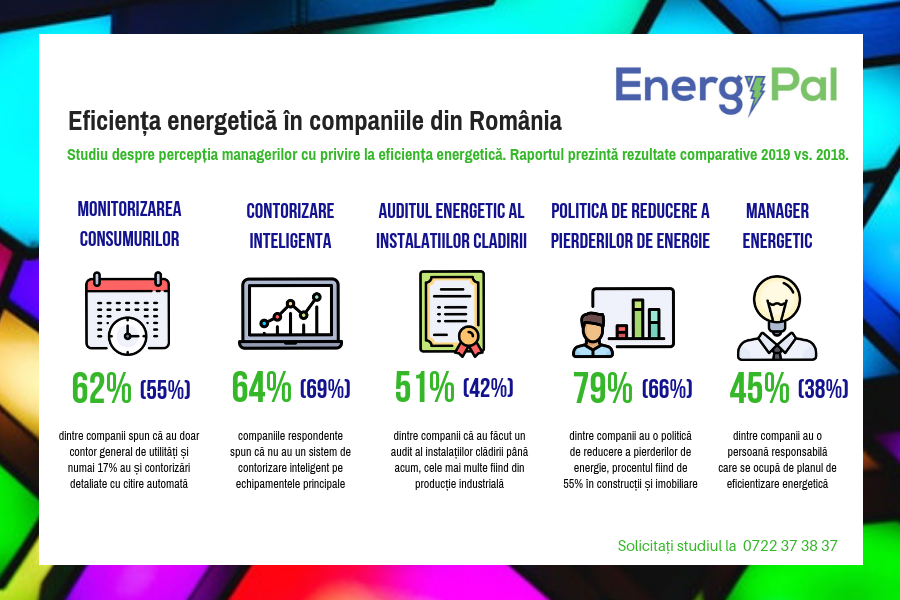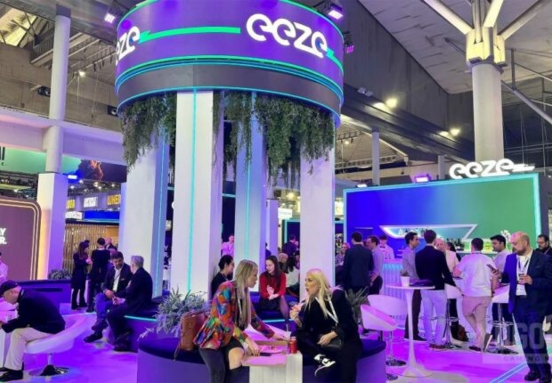On the other hand, 75% of companies have a utility cost-effectiveness policy in 2019, a 6 percentage point increase over the previous year.
"The 2019 edition of the survey on the Energy efficiency in the Romanian companies is based on our intention to disclose the up-to-date picture of how both the legislative framework and the companies' preformance objectives are reflected in this approach. The study further indicates a relatively low level of awareness of the role that energy efficiency measures play in the company's sustainable operation.
The comparative data between the 2019 and 2018 editions show small evolutions on certain levels, but some more courageous developments on others. It is clear that acting on an informed basis, following expert advice, measuring and quantifying on a permanent basis, companies understand that they can take action to increase energy efficiency and reduce short, medium- and long-term energy losses”, says Lucian Anghel, Founder and CEO, EnergyPal Romania.
Most of the respondents (61% in 2019 compared to 62% in 2018) say that energy efficiency means the ratio between the result of performance, services, goods or energy and the energy used for that purpose. On the other hand, 17% this year, compared to 14% last year, identifies this concept with the ability to perform a low-energy action.
The current level of consumption monitoring
In 2019, 62% of companies, rising from 55% in 2018, the current level of consumption monitoring in the company is only achieved through a general utility meter, and 40% in 2019 compared to 34% in 2018 with internal readings with manual reading. This year, only 25% of respondents say they also have detailed internal readings with automatic reading, up from 17% in the previous edition.
We see an increase from 7% in 2018 to 12% in 2019 of the percentage of companies that have exportable consumption data in Excel, while the percentage of companies with an integrated energy consumption and production monitoring remains constant at 7%.
The policy of reducing energy losses
A positive trend is indicated by the fact that 79% of respondents in 2019, compared to 66% in 2018, say they have a policy of reducing energy loss within the company - an increase of 13 percentage points over the past 12 months.
A significant percentage of 75% of respondents say they have a cost-effective utility policy in 2019, an increase of 6 percentage points over the previous year.
Low focus on energy efficiency policy
Only 4 out of 10 companies say they have invested in an energy efficiency program. At the industry level, the fewest companies with such investments are in construction/real estate (20% in 2019 compared to 19% in 2018), followed by those in food/agriculture (21% vs. 29%) and professional services (32% versus 27%).
The EnergyPal study also reveals that the percentage of respondents who say they have made an energy audit of buildings is 51% in 2019, up 9 percentage points over last year. Most companies that carried out an energy audit of buildings are those in industrial production (69%).
Assigning the role of Energy Manager
If last year, 38% of the responding companies said they had a responsible person in the company that is in charge of the energy efficiency plan (energy manager), in 2019 the percentage grows to 45%. The smallest companies with such a role are from transport (18%), followed by industrial production (20%) and food / agriculture (23%).
Unfortunately, on industry analysis, we note that most respondents in construction / real estate (54%) did not train employees on how to conserve energy, as opposed to 60% of industrial manufacturing companies and 61 % of shipments.
"The Facility Management Services market tends to become more and more dynamic with technological developments and the desire of the owners to provide customers with generous spaces at a very high quality standard. The difference is made by those players who understand that Facility Management is not just hiring an installer or an electrician.
Facility Management means digitization, systematization, organization and, perhaps, the most important element, transparency. Our beneficiaries must be able to understand and evaluate tangible things such as: the quality of the water they consume, the quality of the air they breathe, and, finally, the quality of the working environment in which they operate. All these elements are the foundation on which energy efficiency is being built", says Alexandru Theodor Miculaş, Head of Facility Management Services, FMS Romania, co-author of the study. (source: EnergyPal)







